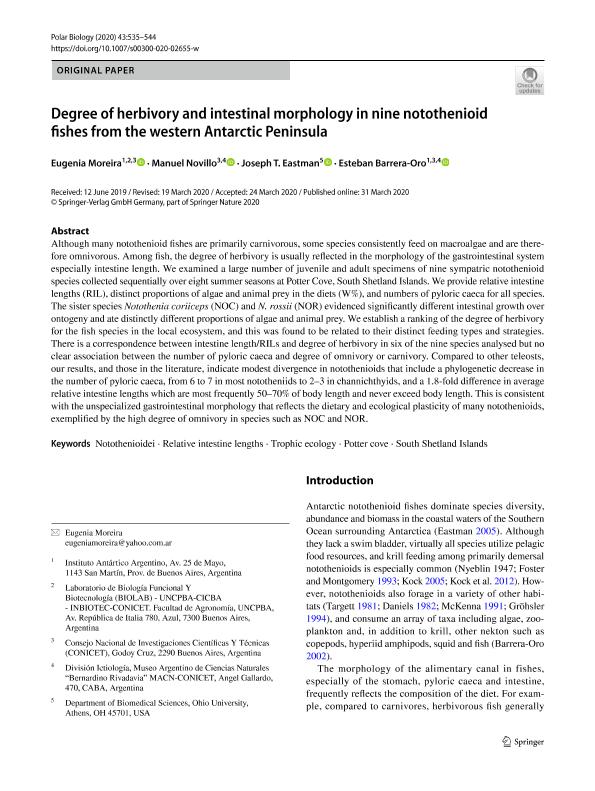Mostrar el registro sencillo del ítem
dc.contributor.author
Moreira, María Eugenia

dc.contributor.author
Novillo, Manuel
dc.contributor.author
Eastman, Joseph T.
dc.contributor.author
Barrera Oro, Esteban

dc.date.available
2021-05-31T15:46:18Z
dc.date.issued
2020-05
dc.identifier.citation
Moreira, María Eugenia; Novillo, Manuel; Eastman, Joseph T.; Barrera Oro, Esteban; Degree of herbivory and intestinal morphology in nine notothenioid fishes from the western Antarctic Peninsula; Springer; Polar Biology; 43; 5; 5-2020; 535-544
dc.identifier.issn
0722-4060
dc.identifier.uri
http://hdl.handle.net/11336/132848
dc.description.abstract
Although many notothenioid fishes are primarily carnivorous, some species consistently feed on macroalgae and are therefore omnivorous. Among fish, the degree of herbivory is usually reflected in the morphology of the gastrointestinal system especially intestine length. We examined a large number of juvenile and adult specimens of nine sympatric notothenioid species collected sequentially over eight summer seasons at Potter Cove, South Shetland Islands. We provide relative intestine lengths (RIL), distinct proportions of algae and animal prey in the diets (W%), and numbers of pyloric caeca for all species. The sister species Notothenia coriiceps (NOC) and N. rossii (NOR) evidenced significantly different intestinal growth over ontogeny and ate distinctly different proportions of algae and animal prey. We establish a ranking of the degree of herbivory for the fish species in the local ecosystem, and this was found to be related to their distinct feeding types and strategies. There is a correspondence between intestine length/RILs and degree of herbivory in six of the nine species analysed but no clear association between the number of pyloric caeca and degree of omnivory or carnivory. Compared to other teleosts, our results, and those in the literature, indicate modest divergence in notothenioids that include a phylogenetic decrease in the number of pyloric caeca, from 6 to 7 in most nototheniids to 2–3 in channichthyids, and a 1.8-fold difference in average relative intestine lengths which are most frequently 50–70% of body length and never exceed body length. This is consistent with the unspecialized gastrointestinal morphology that reflects the dietary and ecological plasticity of many notothenioids, exemplified by the high degree of omnivory in species such as NOC and NOR.
dc.format
application/pdf
dc.language.iso
eng
dc.publisher
Springer

dc.rights
info:eu-repo/semantics/openAccess
dc.rights.uri
https://creativecommons.org/licenses/by-nc-sa/2.5/ar/
dc.subject
NOTOTHENIOIDEI
dc.subject
POTTER COVE
dc.subject
RELATIVE INTESTINE LENGTHS
dc.subject
SOUTH SHETLAND ISLANDS
dc.subject
TROPHIC ECOLOGY
dc.subject.classification
Biología Marina, Limnología

dc.subject.classification
Ciencias Biológicas

dc.subject.classification
CIENCIAS NATURALES Y EXACTAS

dc.title
Degree of herbivory and intestinal morphology in nine notothenioid fishes from the western Antarctic Peninsula
dc.type
info:eu-repo/semantics/article
dc.type
info:ar-repo/semantics/artículo
dc.type
info:eu-repo/semantics/publishedVersion
dc.date.updated
2021-05-28T16:02:40Z
dc.journal.volume
43
dc.journal.number
5
dc.journal.pagination
535-544
dc.journal.pais
Alemania

dc.journal.ciudad
Berlín
dc.description.fil
Fil: Moreira, María Eugenia. Ministerio de Relaciones Exteriores, Comercio Interno y Culto. Dirección Nacional del Antártico. Instituto Antártico Argentino; Argentina. Consejo Nacional de Investigaciones Científicas y Técnicas. Centro Cientifico Tecnolológico Mar del Plata. Instituto de Investigaciones en Biodiversidad y Biotecnología. Laboratorio de Biología Funcional y Biotecnología; Argentina
dc.description.fil
Fil: Novillo, Manuel. Consejo Nacional de Investigaciones Científicas y Técnicas. Oficina de Coordinación Administrativa Parque Centenario. Museo Argentino de Ciencias Naturales "Bernardino Rivadavia"; Argentina
dc.description.fil
Fil: Eastman, Joseph T.. Ohio State University; Estados Unidos
dc.description.fil
Fil: Barrera Oro, Esteban. Ministerio de Relaciones Exteriores, Comercio Interno y Culto. Dirección Nacional del Antártico. Instituto Antártico Argentino; Argentina. Consejo Nacional de Investigaciones Científicas y Técnicas. Oficina de Coordinación Administrativa Parque Centenario. Museo Argentino de Ciencias Naturales "Bernardino Rivadavia"; Argentina
dc.journal.title
Polar Biology

dc.relation.alternativeid
info:eu-repo/semantics/altIdentifier/url/http://link.springer.com/10.1007/s00300-020-02655-w
dc.relation.alternativeid
info:eu-repo/semantics/altIdentifier/doi/http://dx.doi.org/10.1007/s00300-020-02655-w
Archivos asociados
